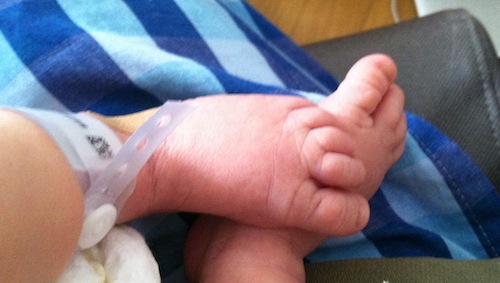One of the reasons I love teaching anthropology is that it is so easy to draw a direct connection between what we are studying the the real life experiences of my students. The actions of evolution are ubiquitous in the world around us. Human biological variation, though differentially noticed, is unavoidable once you are made aware of it.
The connection between the real world and my teaching has taken on a unique element this semester, however, owing to the birth of my first child. I have seen several other biological anthropologists go through this process, and it is always fascinating to watch them identify evolutionary stages of development in their child, as well as experience such evolutionarily critical events, like childbirth, in their own lives. It is no different for me, although in my case, the real coincidental alignment between life and teaching comes via my personal genomics course (Anth 314 – Human Biology and Society). As part of this course my students had the opportunity to get genotyping done via 23andme.com, a service that I took advantage of just prior to the start of the semester, as well.
So all semester long I have been waiting for my personal genetic data to come back. As the anticipated arrival date of the little one got closer, I amusedly tweeted that it was looking more and more like the arrival of my personal genetic information and first child were going to be simultaneous events. The birth of our son was a planned c-section, and on the day of the event, I opted to use my phone as the least cumbersome camera in the operating room. Everything related to the procedure went wonderfully and our son was officially born at 1:14 pm. Within a few minutes, I was snapping pictures of him under the warming lamp, watching him get his initial screening from the nurses. A few minutes later, I was holding him alongside my wife, placing him on my wife’s chest, and taking pictures of it all.
And then, at 1:29pm, the banner alert across my phone said, “Your 23andMe results are ready!”
There I was, holding this 8 pound, 6 ounce package of newly emerged perfection in my arms, and there at the tip of my fingers, was a window into the genetic endowment I had provided him.
Throughout the semester, one of the issues we have returned to repeatedly is the complex social and ethical issues raised by the reality that your genome is not solely your own. It is inherited from your parents, shared with your siblings, and passed on to your children. Genetic information about you, and the knowledge generated by it, is not bounded by your own existence. If I was a carrier for something dramatic, it would also mean that at least one of my parents were as well, and it would mean this creation in my arms stood a 50% chance of inheriting that trait.
The very first assignment in our course was to put together, to the best of each student’s ability, a detailed family medical history. I did this exercise alongside my students and reaffirmed that in addition to being remarkably long-lived, there are not many (if any) red flags in my family history. Family medical histories are a pretty good preview of your genome in many ways, so I did not have any particular anxieties about finding a genetic goblin within my own data (Razib Khan and John Hawks had some interesting comments on family medical histories last week, by the way). Nevertheless, the alignment of events connecting my life and my teaching reached a dramatic level unlike anything I have experienced previously.
Over the span of the next several days, as my wife and I began the process of meeting our son, introducing him to the rest of our family, and developing new sleep habits, I gradually began to explore my 23andme data. I found myself gravitating towards the things I already know about myself. Risk for melanoma (something I have twice been diagnosed with) – lower than average according to 23andMe’s data. Risk for migraines (something I have recently experienced) – also lower than average. Bitter taster, yes. Brown eyes, yes. Fast caffeine metabolizer, yes. Major future health concerns indicated by the million or so SNPs 23andMe had typed – not really (though there is one topic I might explore in more depth later).
The process of comparing the knowledge (or at least information) given to me by 23andMe and my own existing knowledge reflected another class topic that has come up repeatedly. How do we integrate different kinds of knowledge? Personal genetic or genomic information reflects, potentially, a vast amount of knowledge about the basic underlying structure of your biology (it certainly contains a lot of information, anyway). Meanwhile, throughout your own life, we all accumulate a certain experiential knowledge about who we are as biological creatures with “known” relationships. In those initial days in the hospital and in the two weeks since, I cannot help but acknowledge how much I privilege the experiential knowledge generated by seeing my son–watching him notice the world, hearing him cry, wiggling his ten little toes and grabbing hold of me with his surprisingly strong ten little fingers–over the abstract knowledge of my own genetic endowment.

